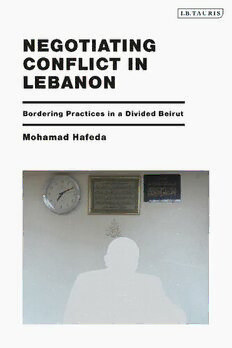
Negotiating Conflict in Lebanon: Bordering Practices in a Divided Beirut PDF
Preview Negotiating Conflict in Lebanon: Bordering Practices in a Divided Beirut
NEGOTIATING CONFLICT IN LEBANON Bordering Practices in a Divided Beirut MOHAMAD HAFEDA To the two poles of the journey: Marya and Karim, and my grandmother Fayza. CONTENTS 4 INTRODUCTION: Bordering Practices ADMINISTRATION 36 Bordering Practice 01: Hiding The Chosen Two SURVEILLANCE 102 Bordering Practice 02: Crossing At Her Balcony SOUND 158 Bordering Practice 03: Translating This is How Stories of Conflict Circulate and Resonate DISPLACEMENT 208 Bordering Practice 04: Matching The Twin Sisters are ‘About to’ Swap Houses 258 EPILOGUE: Temporal Bordering Practices of Resistance 266 ENDNOTES 273 BIBLIOGRAPHY 278 LIST OF FIGURES 280 LIST OF INTERVIEWS 281 ACKNOWLEDGEMENTS 284 INDEX Introduction: Bordering Practices Fig.01 Demarcation line: Mazraa Main Road. On 23 January 2007 Beirut woke up to the eruption of sectarian violence. On that day a general strike was implemented in Lebanon by the 8 March bloc with the aim of bringing down the government of the 14 March bloc, these having been the two rival political blocs in the country since 2005. Young men took control of the streets, changing the material arrangement of political and social life: they blocked roads with burning tyres and sand from construction sites, and they created human barriers to sever main roads and to prevent pedestrians from passing to get to their jobs. The events led to confrontations and violent clashes between supporters of the rival blocs on the streets of Beirut, and to the emergence of demarcation lines cutting across neighbourhoods. One of the major demarcation lines was the Mazraa Main Road separating Tarik Al Jdide from Mazraa area. A couple of days after the Lebanese army had cleared the roadblocks, I followed the traces of the burning tyres on the streets and pavements. I was looking to learn about and piece together the new political and sectarian map of power and segregation drawn by the remaining black fumes. It was a task that proved to be difficult, primarily because of the intricacy and intertwining of the demarcation lines created by the mix of communities and political parties in the city, but also due to the fear I felt while wandering the streets with my camera among groups of angry men. However, the key questions this event raised for me, especially after the material evidence of violence had been cleared away – the evidence that I had been attempting to follow – were: What is a border made of, and where, how, and when is it created? Can it disappear and, if so, what happens afterwards? With these questions in mind, I started to consider how borders transform, and are transformed by, the lives of residents and city spaces. Not able to quite grasp the fluctuating border, I embarked on the current site-specific practice-led research project that I now present. 6 Introduction Fig.02 (Here and Overleaf) Photographs taken from residents’ interior spaces, asking them about the trace left of violent clashes and physical borders, The Trace Series, 2010–present. Bordering Practices 7 8 Introduction Bordering Practices 9
